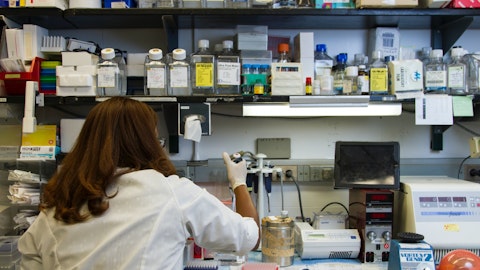By hitting TSLP upstream, we think we can really have an impact on the disease biology. We see TSLP-elevated in the serum patients in bronchial mucosa [PH] and bronchoalveolar lavage fluid. It’s released by airway epithelium. There’s just a lot of signals from the basic biology of this disease pointing to a medicine of this nature. And by looking at the broader population than they did with Dupi, we have a chance to really figure out who the responder is. Murdo?
Murdo Gordon: I think you’ve covered all the bases. I would just add this, Evan, that with the unique and differentiated mechanism, as Jay described, we hope we can treat a broader population of patients than perhaps the currently available therapies. And we also recognize that there are patients who are refractory to those currently available therapies, and we would obviously want to understand if they would be responders to TEZSPIRE. I think we’ve got strong commercial capabilities, including with our partners at AstraZeneca and are well positioned to take a product like this into the market if we’re successful in Phase III.
Justin Claeys: Okay. All right. Thank you, Julian. Next question?
Operator: Thank you, Evan. Our next question comes from Umer Raffat from Evercore ISI. Please go ahead. Your line is open.
Umer Raffat: Hi, guys. Thanks for taking my question. I wanted to touch up on AMG 133 as well, two parts question. First, on the discontinuations at the high dose, we know five out of eight did not finish the full duration of the study, but there was a second arm also of this high dose 420-milligram with 10 patients, which was not reported. This was the one with digital tools. Could you speak to the discontinuation rate in that arm? So this a 420 done separately, which is not part of paper? And secondly, I know there’s a case of liver enzyme elevation of the 280-meg dose, but this patient also had COVID. Could you perhaps speak to the timing of liver enzyme elevation relative to the COVID episode? Thank you very much.
Robert Bradway: Yes. Thanks, Umer. I won’t be able to provide patient level insights to the Phase I study at this time, but I do appreciate your question and your interest in the report. I’ll speak to the dropouts of the Phase 1 at the 420-milligram dose, which was four out of the eight patients. First, it’s notable to say that the high-dose cohort in the multiple ascending dose receiving the three doses of 420 experienced real weight loss, real benefit of 14.5% after these three monthly doses. This was the group that proved actually quite durable out to day 150. Four subjects decline to participate in this clinical study setting largely from logistical reasons. The AEs and other characteristics were comparable to all the other patients in the study. Now the second question around the digital group, I don’t have insight into that. Dave, do you…
David Reese: No. I mean we can get back to you on that. I don’t know that we reported that – those data and the discontinuation rate.
Justin Claeys: Julianne, next question.
Operator: Thank you, Umer. Our next question comes from Colin Bristow from UBS. Please go ahead. Your line is open.
Colin Bristow: Good afternoon and thanks for taking the questions. Maybe a couple more on MariTide. First, could you provide some insight into the dosing? I mean, obviously, these are pretty large doses. And if we look at like Repatha for 20 milligrams takes over 5 minutes by infusion or 3 infective injections. So I was wondering if you could give any insight there. And then in terms of the relative affinity for gip versus GLIP [ph] MariTide seams to have preferentially favor GLIP much more than competitor molecules. And so do you think the ultimate clinical profile is more closely going to resemble that of a long-acting glip-1 versus competitive git GLIPS [ph]? Thanks.
Robert Bradway: Yes. Thanks, Colin. I appreciate the deep consideration of the molecule, especially. I’d start by saying, I don’t regard these doses as high. I’m new here, but 420 milligrams for biotherapeutic that’s an antibody drug conjugate with a peptide antibody ratio 2:1 seems well in scope for a modern biotherapeutic product. I don’t need to tell this community paying so close – such close attention to Amgen that this is a very sophisticated biotherapeutics organization. And on the manufacturing side, just every patient, every time. And we have all the capabilities necessary to deliver this medicine at whichever of these three or other dose and schedule we arrived at. So no concerns there for me whatsoever. Regarding the balance of the pharmacology, you do invoke a difference between our medicine and medicines developed by pure pharmaceutical companies.
Namely mechanistically the core antibody of MariTide inhibits the GIP receptor, whereas these other peptide medicines agonize it. We feel very secure in our choice to inhibit that receptor supported by just the finest level of experimental data available experiments of nature that genome-wide association studies in very large populations have pointed to a need, an opportunity to inhibit the gift receptor to deliver lower BMI as observed with variance in that receptor and downstream signaling pathways that correlate with reduced body mass index in large populations. As to the balance, which you asked, between inhibition of GIP receptor and agonism of GLP-1, these are very difficult measurements to make in humans, but our modeling suggests that with the therapeutic doses and exposures that we observe that we’re achieving both.
Murdo Gordon: And Colin, this is Murdo. I would just add that from a patient experience perspective, we’ve learned a lot from other biologics. And Amgen has a world-class process development, manufacturing and device team, and we’ve done a lot of work on this one, and we anticipate a very positive and simple patient experience on at least a monthly dosing schedule. And we’ve learned a lot from Repatha specifically, and there’s more to follow on Repatha from that, but we continue to work to improve patient experience with our biologic injectables.
Jay Bradner: Just as we go to the next question, let me observe that we’re almost up to the hour that we actually all to set aside, but I know we still have quite a few questions in the queue. So we’ll try to get one question for a caller here and get through. We’ll stay through the queue of calls or questions rather that’s still waiting for us, but I know some of you may have to drop. So let’s move forward, Justin.
Justin Claeys: Julianne. Next question please.
Operator: Thank you, Collin. Our next question comes from Yaron Werber from TD Cowen. Please go ahead. Your line is open.
Q – Unidentified Analyst: All right. Great, thanks. This is Brendan on for Yaron. Thanks for taking the question. Just a quick one from us. Actually, based on the data you’ve seen so far and maybe some feedback from physicians that you’ve heard, this is on UPLIZNA. Where do you kind of see UPLIZNA fitting into maybe the MG treatment paradigm given all the competition there, but maybe more to the point, how you’re thinking about expansion opportunities given all the different autoimmune indications you could potentially pursue? Just trying to kind of understand how you see longer-term growth there?
Robert Bradway: First, why don’t we ask Vikram, just to address the performance of the product right now in NMOSD. And then a combination of Jay and Dave can talk about the other activities or other potential applications.
Vikram Karnani: Yes. Thanks for the question. Yes, UPLIZNA is actually growing quite nicely and quite well in NMOSD. As you know, it is now the fastest-growing biologic in NMOSD. We continue to execute across a variety of fronts. I mean, we’re – we see this product nicely positioned versus as it’s appropriate for NMOSD patients and within the competitive environment that we operate in. We’ve continued to make significant progress over the last 18 months or so, maybe even longer of continuing to drive more growth with newer prescribers and even depth with existing prescribers. So the product continues to do well. And I think we hope to continue to deliver good execution on this medicine in NMOSD. Maybe, Jay, you want to talk about the second question?
Jay Bradner: Yes. No, I’m happy to. As you may know, on a hematologist, I think CD19 is a terrific target. It’s expressed really on all B cells and spares plasma cells. And therefore, considering indication expansion, as you’ve asked, there’s a large number of diseases that could potentially be approached with UPLIZNA to the real benefit of patients with unmet need, far beyond the application of the prevailing CD20s that target just a subset of B cells. This is not lost on our team, and we’re working through indication expansion priorities presently.
Justin Claeys: Julian, let’s got the next question.
Operator: Thank you. Our next question comes from Mohit Bansal from Wells Fargo. Please go ahead. Your line is open.
Mohit Bansal: Great. Thank you very much for taking my question. I have a question regarding the subcutaneous delivery of TEPEZZA. You do have a plan to initiate a Phase III study. Can you talk a little bit about which technology you are using? Is this with the pre-existing Halozyme technology? Or are you using something else for this development? Thank you.
Robert Bradway: Sorry, I had trouble understanding your question.
Murdo Gordon: The question is what technology we’re using for the subcutaneous injectable form of TEPEZZA?
Robert Bradway: Maybe I’ll jump in. Mohit, we’re not commenting at this point on the provider. We just said that we’re going forward with the subcu.
Justin Claeys: Okay, Julian, we’ll go to next question.
Operator: Thank you, Mohit. Our next question comes from Geoff Meacham from Bank of America. Please go ahead. Your line is open





